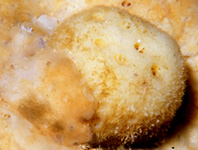Abstract
A new species of hippolytid shrimp, Hippolyte ngi n. sp., is described and illustrated based on specimens collected from the Indo-West Pacific region. The new species clearly belongs to the ‘Hippolyte ventricosa H. Milne Edwards, 1837’ species complex, but is distinguished from its congeners by the dactylus of the last three pereiopods, the position of the hepatic spine, the proportions of the segments of the antennular peduncle, and other subtle but constant features.
References
Baeza, J.A., Schubart, C.D., Zillner, P., Fuentes, S. & Bauer, R.T. (2009) Molecular phylogeny of shrimps from the genus Lysmata (Caridea: Hippolytidae): the evolutionary origins of protandric simultaneous hermaphroditism and social monogamy. Biological Journal of the Linnean Society, 96, 415–424.
https://doi.org/10.1111/j.1095-8312.2008.01133.xBracken, H.D., de Grave, S. & Felder, D.L. (2009) Phylogeny of the Infraorder Caridea based on mitochondrial and nuclear genes (Crustacea: Decapoda). In: Martin, J.W., Crandall, K.A. & Felder, D.L. (Eds.), Decapod Crustacean Phylogenetics. CRC Press, Taylor & Francis Group Boca Raton, FL, pp. 281–305.
https://doi.org/10.1201/9781420092592-c14Crandall, K.A. & Fitzpatrick, J.F. Jr. (1996) Crayfish molecular systematics: using a combination of procedures to estimate phylogeny. Systematic Biology, 45, 1–26.
https://doi.org/10.1093/sysbio/45.1.1De Grave, S. & Fransen, C.H.J.M. (2011) Carideorum catalogus: the recent species of the Dendrobranchiate, Stenopodidean, Procarididean and Caridean Shrimps (Crustacea: Decapoda). Zoologische Mededelingen, 85, 195–589.
De Grave, S., Li, C.P., Tsang, L.M., Chu, K.H. & Chan, T.-Y. (2014) Unweaving hippolytoid systematics (Crustacea, Decapoda, Hippolytidae): resurrection of several families. Zoologica Scripta, 43, 496–507.
https://doi.org/10.1111/zsc.12067Edgar, R.C. (2004) MUSCLE: multiple sequence alignment with high accuracy and high throughput. Nucleic Acids Research, 32, 1792–1797.
https://doi.org/10.1093/nar/gkh340Guindon, S. & Gascuel, O. (2003) A simple, fast, and accurate algorithm to estimate large phylogenies by maximum likelihood. Systematic Biology, 52, 696–704.
https://doi.org/10.1080/10635150390235520Hale, H.M. (1927) The Crustacea of South Australia. Part I. Government Printer, Adelaide, 201 pp.
Hale, H.M. (1928) Some Australian decapod Crustacea. Records of the Australian Museum, 4, 91–104.
Hayashi, K.I. (1981) The Central Pacific shrimps of the genus Hippolyte, with a description of two new species (Decapoda, Caridea, Hippolytidae). Pacific Science, 35, 185–196.
Hayashi, K. & Miyake, S. (1968) Studies on the hippolytid shrimps from Japan, V. Hippolytid fauna of the sea around the Amakusa marine biological laboratory. Journal of the Faculty of Agriculture Kyushu University, 1, 121–163.
Holthuis, L.B. (1947) The Hippolytidae and Rhynchocinetidae collected by the Siboga and Snellius Expedition with remarks on other species. Siboga Expeditie Monographs, 39a, 1–100.
Huelsenbeck, J.P. & Ronquist, F. (2001) MRBAYES: Bayesian inference of phylogeny. Biometrics 17, 754–755.
Ledoyer, M. (1970) Étude systématique et remarques écologiques sur les Caridea recueillis principalement dans les biotopes de substrat meuble. Régions de Tuléar et de Nosy-Bé. Annales de l’Université de Madagascar (Sciences Naturelles et Mathématiques), 7, 121–157.
Posada, D. & Crandall, K.A. (1998) Modeltest: testing the model of DNA substitution. Bioinformatics, 14, 817–818.
https://doi.org/10.1093/bioinformatics/14.9.817Terossi, M. & Mantelatto, F.L. (2012) Morphological and genetic variability in Hippolyte obliquimanus Dana, 1852 (Decapoda, Caridea, Hippolytidae) from Brazil and the Caribbean Sea. Crustaceana, 85, 685–712.
https://doi.org/10.1163/156854012X643762d’Udekem d’Acoz, C. (1996) The genus Hippolyte Leach, 1814 (Crustacea: Decapoda: Caridea: Hippolytidae) in the East Atlantic Ocean and the Mediterranean Sea, with a checklist of all species in the genus. Zoologische Verhandelingen, 303, 1–133.
d’Udekem d’Acoz, C. (1999) Redescription of Hippolyte ventricosa H. Milne Edwards, 1837 based on syntypes, with remarks on Hippolyte orientalis Heller, 1862 (Crustacea, Decapoda, Caridea). Zoosystema, 21, 65–76.
d’Udekem d’Acoz, C. (2001) Redescription of Hippolyte australiensis (Stimpson, 1860) (Crustacea, Decapoda, Caridea). Biologie, 71, 37–44.
d’Udekem d’Acoz, C. (2007) New records of Atlantic Hippolyte, with the description of two new species, and a key to all Atlantic and Mediterranean species (Crustacea, Decapoda, Caridea). Zoosystema, 29, 183–207.
Yanagawa, S.I. & Watanabe, S. (1988) Life history and morphology of the hippolytid shrimp Hippolyte ventricosa in Kominato Bay. Nippon Suisan Gakkaishi, 54, 613–618.
https://doi.org/10.2331/suisan.54.613

